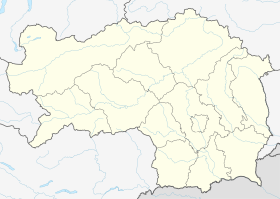
The history of Styria concerns the region roughly corresponding to the modern Austrian state of Styria and the Slovene region of Styria (Štajerska) from its settlement by Germans and Slavs in the Dark Ages until the present. This mountainous and scenic region, which became a centre for mountaineering in the 19th century, is often called the "Green March", because half of the area is covered with forests and one quarter with meadows, grasslands, vineyards and orchards. Styria is also rich in minerals, soft coal and iron, which has been mined at Erzberg since the time of the Romans. The Slovene Hills is a famous wine-producing district, stretching between Slovenia and Austria. Styria was for long the most densely populated and productive mountain region in Europe.

The Mur or Mura is a river in Central Europe rising in the Hohe Tauern national park of the Central Eastern Alps in Austria with its source at 1,898 m (6,227 ft) above sea level. It is a tributary of the Drava and subsequently the Danube.

The Carinthian plebiscite was held on 10 October 1920 in the area in southern Carinthia predominantly settled by Carinthian Slovenes. It determined the final border between the Republic of Austria and the newly formed Kingdom of Serbs, Croats and Slovenes (Yugoslavia) after World War I. The predominantly Slovene-speaking plebiscite area voted to remain part of Austria with a 59% majority.

Bruck an der Mur is a city of some 15,970 people located in the district Bruck-Mürzzuschlag, in the Austrian state of Styria. It is located at the confluence of the rivers Mur and Mürz. Its manufacturing includes metal products and paper. Bruck is located on the Graz to Vienna main line, and is an important regional rail junction.

Bleiburg is a small town in the south Austrian state of Carinthia (Koroška), south-east of Klagenfurt, in the district of Völkermarkt, some four kilometres from the border with Slovenia.
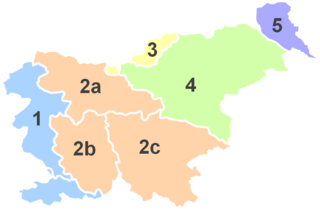
Prekmurje is a geographically, linguistically, culturally and ethnically defined region of Slovenia, settled by Slovenes and a Hungarian minority, lying between the Mur River in Slovenia and the Rába Valley in the westernmost part of Hungary. It maintains certain specific linguistic, cultural and religious features that differentiate it from other Slovenian traditional regions. It covers an area of 938 square kilometers (362 sq mi) and has a population of 78,000 people.

Styria, also known as Slovenian Styria or Lower Styria to differentiate it from Austrian Styria, is a traditional region in northeastern Slovenia, comprising the southern third of the former Duchy of Styria. The population of Styria in its historical boundaries amounts to around 705,000 inhabitants, or 34.5% of the population of Slovenia. The largest city is Maribor.
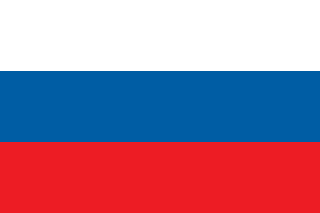
The Duchy of Carniola was an imperial estate of the Holy Roman Empire, established under Habsburg rule on the territory of the former East Frankish March of Carniola in 1364. A hereditary land of the Habsburg monarchy, it became a constituent land of the Austrian Empire in 1804 and part of the Kingdom of Illyria until 1849. A separate crown land from 1849, it was incorporated into the Cisleithanian territories of Austria-Hungary from 1867 until the state's dissolution in 1918. Its capital was German: Laibach, today Ljubljana.

Wildon is a small town located between Leibnitz and Graz in the Austrian country of Styria.

Gornja Radgona is a town in Slovenia. It is the seat of the Municipality of Gornja Radgona. Once it was a defensive stronghold for today's regional centre and its twin city, Bad Radkersburg, on the other side of the Mura River in Austria. The towns were split in 1919, when the state of Styria was divided between Austria and Slovenia. They afterward developed separately, and Gornja Radgona grew into a new town centre.

Feldbach is a town in the southeast of the Austrian state of Styria, near the Slovenian and Hungarian border. It is located in the valley around the river Raab. With 13,421 inhabitants, Feldbach is the fifth largest town in Styria.

Bad Sankt Leonhard im Lavanttal is a spa town in the district of Wolfsberg in the Austrian state of Carinthia.
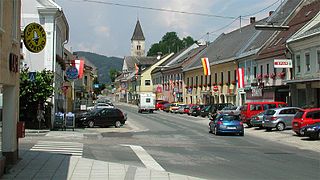
Lavamünd is a market town in the district of Wolfsberg in the Austrian state of Carinthia.

The Duchy of Styria was a duchy located in modern-day southern Austria and northern Slovenia. It was a part of the Holy Roman Empire until its dissolution in 1806 and a Cisleithanian crown land of Austria-Hungary until its dissolution in 1918.

Mureck is a municipality in the district of Südoststeiermark in the Austrian state of Styria. Administrative reforms in Styria led to the merging on 1 January 2015 of the formerly separate municipalities of Mureck, Gosdorf, and Eichfeld, which includes the villages of Hainsdorf-Brunnsee and Oberrakitsch. The new municipality is named Mureck.

The Slovene lands or Slovenian lands is the historical denomination for the territories in Central and Southern Europe where people primarily spoke Slovene. The Slovene lands were part of the Illyrian provinces, the Austrian Empire and Austria-Hungary. They encompassed Carniola, southern part of Carinthia, southern part of Styria, Istria, Gorizia and Gradisca, Trieste, and Prekmurje. Their territory more or less corresponds to modern Slovenia and the adjacent territories in Italy, Austria, Hungary, and Croatia, where autochthonous Slovene minorities live. The areas surrounding present-day Slovenia were never homogeneously ethnically Slovene.

Gornja Radgona railway station serves the municipality of Gornja Radgona, Slovenia. It was opened on 16 October 1890, as part of the extension of the Radkersburger Bahn from Bad Radkersburg, in present-day Austria, to Ljutomer, in present-day Slovenia.

Marburg's Bloody Sunday was a massacre that took place on Monday, 27 January 1919 in the city of Maribor in Slovenia. Soldiers from the army of the Kingdom of Serbs, Croats and Slovenes, under the command of Slovene officer Rudolf Maister, killed between 9 and 13 civilians of German ethnic origin, wounding a further 60, during a protest in a city centre square. Estimates of casualties differ between Slovene and Austrian sources.
The Austro-Slovene conflict in Carinthia was a military engagement that ensued in the aftermath of World War I between forces loyal to the State of Slovenes, Croats and Serbs and later the Kingdom of Serbs, Croats and Slovenes, and forces loyal to the Republic of German-Austria. The main theater of the conflict was the linguistically mixed region in southeastern Carinthia. The conflict was settled by the Treaty of Saint-Germain in 1919, which stipulated that the territorial dispute be resolved by a plebiscite.
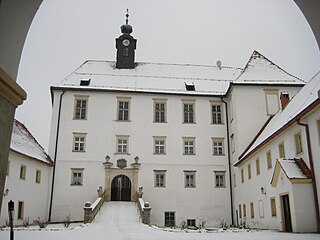
Gornja Radgona Castle is a castle in Gornja Radgona, Slovenia.


